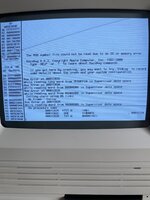@Chopsticks Thank you for your thorough input.
I think I need to get creative to find the issue.
My ROM socket has a broken clip and I have to force the SIMM to sit as far forward as possible with rubber bands. I just got a IIsi which has a ROM SIMM socket with metal clips that I was thinking to donate to the SE/30, since this will never be used due to it having onboard ROM chips.
I may get the Rominator II as I’d like to try a different ROM SIMM, if changing the socket doesn’t help. I’ve heard these can occasionally go bad, like RAM.
I’m not sure if dishwashing the board was a good idea anymore but note that I didn’t use any detergent.
My SCSI issues are solved but I will check the voltages on boot up as you suggest. The good thing about my IIsi aquisition is that I can now test my HDs and RAM outside the problematic SE/30.
Is it normal in MacsBug btw for there to appear a line that says ‘the ROM symbol file could not be read’? I attach an image of one of my routine crashes.


